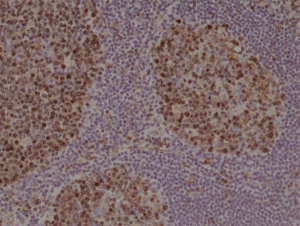anti-Stathmin (human) Rabbit Monoclonal (RM350)
| Code | Size | Price |
|---|
| REV-31-1236-00-R100 | 100 ul | £455.00 |
Quantity:
Prices exclude any Taxes / VAT
Overview
Antibody Isotype: Rabbit IgG
Antibody Clonality: Recombinant Antibody
Antibody Clone: RM350
Regulatory Status: RUO
Target Species: Human
Applications:
- Immunohistochemistry (IHC)
- Western Blot (WB)
Shipping:
Blue Ice
Storage:
+4°C
Images
Documents
Further Information
Alternate Names/Synonyms:
STMN1
Concentration:
N/A
EClass:
32160000
Form (Short):
liquid
Formulation:
Liquid. 50% Glycerol/PBS with 1% BSA and 0.09% sodium azide.
Handling Advice:
Avoid freeze/thaw cycles.
Immunogen:
A peptide corresponding to the C-terminus of human Stathmin.
Long Description:
Recombinant Antibody. This antibody reacts to human Stathmin. It may also react to mouse or rat Stathmin, as predicted by immunogen homology. Applications: WB, IHC. Source: Rabbit. Liquid. 50% Glycerol/PBS with 1% BSA and 0.09% sodium azide. Stathmin belongs to the stathmin family of genes. It encodes a ubiquitous cytosolic phosphoprotein proposed to function as an intracellular relay integrating regulatory signals of the cellular environment. Stathmin regulates microtubule dynamics by promoting depolymerization of microtubules and/or preventing polymerization of tubulin heterodimers. Upon entry into mitosis, microtubules polymerize to form the mitotic spindle, a cellular structure that is essential for accurate chromosome segregation and cell division. The microtubule-depolymerizing activity of stathmin is switched off at the onset of mitosis by phosphorylation to allow microtubule polymerization and assembly of the mitotic spindle. Phosphorylated stathmin has to be reactivated by dephosphorylation before cells exit mitosis and enter a new interphase. Stathmin is critically important for the formation of a normal mitotic spindle upon entry into mitosis and also for the regulation of the function of the mitotic spindle in the later stages of mitosis and for the timely exit from mitosis.
NCBI, Uniprot Number:
P16949
Package Type:
Vial
Product Description:
Stathmin belongs to the stathmin family of genes. It encodes a ubiquitous cytosolic phosphoprotein proposed to function as an intracellular relay integrating regulatory signals of the cellular environment. Stathmin regulates microtubule dynamics by promoting depolymerization of microtubules and/or preventing polymerization of tubulin heterodimers. Upon entry into mitosis, microtubules polymerize to form the mitotic spindle, a cellular structure that is essential for accurate chromosome segregation and cell division. The microtubule-depolymerizing activity of stathmin is switched off at the onset of mitosis by phosphorylation to allow microtubule polymerization and assembly of the mitotic spindle. Phosphorylated stathmin has to be reactivated by dephosphorylation before cells exit mitosis and enter a new interphase. Stathmin is critically important for the formation of a normal mitotic spindle upon entry into mitosis and also for the regulation of the function of the mitotic spindle in the later stages of mitosis and for the timely exit from mitosis.
Purity:
Protein A purified.
Source / Host:
Rabbit
Specificity:
This antibody reacts to human Stathmin. It may also react to mouse or rat Stathmin, as predicted by immunogen homology.
Transportation:
Non-hazardous
UNSPSC Category:
Primary Antibodies
UNSPSC Number:
12352203
Use & Stability:
Stable for at least 1 year after receipt when stored at -20°C.



